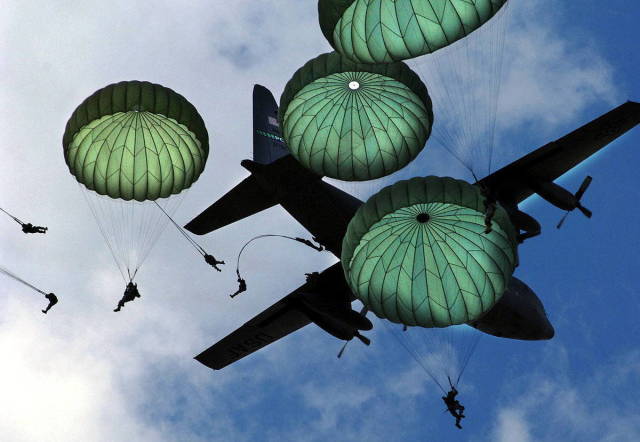The military-political leadership of Germany, in the process of reorganizing the national armed forces, pays considerable attention to the readiness of the Bundeswehr (SV) ground forces to conduct operations "in surface airspace". Airmobile troops (primarily airborne and helicopter units) to increase their combat capabilities are concentrated as part of one unit - the Division of special operations (Division Schnelle Kräfte, DSK).
The command of the German Armed Forces considers the actions of airmobile units as one of the main ways to support large-scale operations of mechanized formations. However, if in the recent past a major airborne operation was considered the main option for their use, then structural changes and reductions in the number of the Bundeswehr as a whole made it necessary to clarify the tasks of airmobile units. According to experts, the current concentration of this kind of troops in one division is a good solution and a prerequisite for the successful completion of various missions.
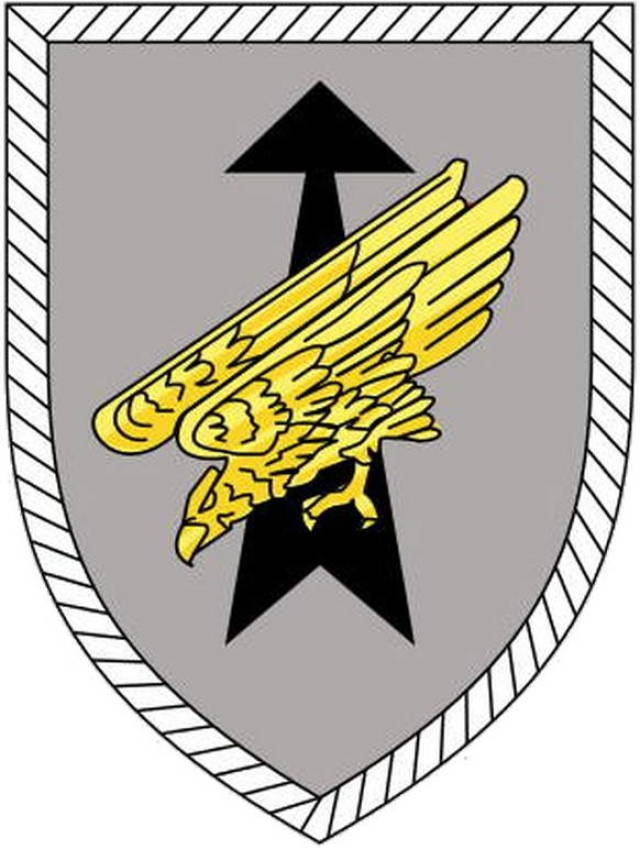
Special Operations Division emblemAirmobile Troops – the core of the Special Operations Division
According to its operational purpose, the Special Operations Division (hereinafter referred to as the DSO) is responsible for conducting special (Spezial) and specialized (Spezielle) missions, combat readiness of helicopter units of army aviation and combat capabilities of SV in the field of airmobile operations.
The division, along with other units, includes the following units of the airmobile forces of the Bundeswehr:
- 1 airborne brigade "Saarland" ("Saarland"), Saarlouis (Saarlouis). 1 vdbr is the core of the German airmobile forces and includes all parachute units;
- Special Forces Command (Kommando Spezialkräfte, KSK), Calv (Calw);
- 36 regiment of attack helicopters "Kurhessen" ("Kurhessen"), Fritzlar;
- 10 regiment of transport helicopters "Lüneburger Heide" ("Lüneburger Heide"), Fassberg (Faßberg);
- 30 transport helicopter regiment, Niederstetten.
A feature of special forces units (SpN) is their operational subordination, as a rule, to the command of a higher strategic level.
Operationally, the DSO also includes the 11th airmobile brigade of the Netherlands Army, Arnheim (Arnheim). As a result, according to publications, the total number of the division is about 11,800 people, of which about 2,300 Dutch and 9,500 German soldiers.
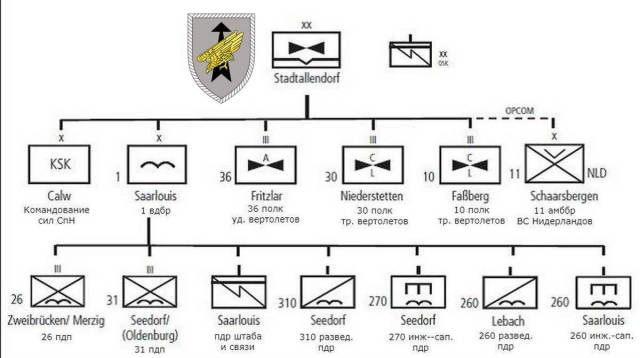
Organizational structure of the DSOThe leadership of airborne units and army aviation units is carried out by the DSO headquarters.
According to the views of the German command, with this approach, airmobile troops receive unified control for all units: attack and transport helicopters, parachute units and additional forces of combat troops, support and support forces.
As a result, it becomes possible to conduct operations of a large operational scope and of varying intensity against a highly mobile enemy, irregular forces, as well as to focus efforts on the main direction. DSO or 1 VDBR can perform tasks within the framework of preventing national crises, as well as conduct military evacuation operations.
Airborne troops of the Bundeswehr
Units and subunits of the airborne troops of Germany are concentrated in the composition of 1 vdbr, namely:
- 26 Parachute Regiment (pdp), Zweibrücken (Zweibrücken);
- 31 pdp, Seedorf (Seedorf);
- Parachute company (pdr) of the headquarters and communications, Saarlouis;
- 260 reconnaissance pdr, Lebach (Lebach);
- 310 reconnaissance pdr, Seedorf;
- 260 engineering and sapper pdr, Saarlouis;
- 270 engineering and sapper pdr, Seedorf.

Emblem of the 1st Airborne Brigade of the BundeswehrAccording to military experts, thanks to their equipment, these units and subunits have mixed combat capabilities and can perform infantry combat missions.
They are suitable for conducting combat operations of any form, on any terrain, under any weather conditions and increasingly in an urban environment.
Infantry and irregular forces are considered as the most likely enemy. Along with the dominant types of operations, paratroopers are often used ahead of the main formations of the Bundeswehr to ensure the success of their operations.
Parachute Regiment
Initially, the 26 pdp SV of Germany is designed for airmobile operations. Opposite 31 pdp – for rescue and evacuation operations. However, the basic organizational structure of these parts allows you to change tasks.
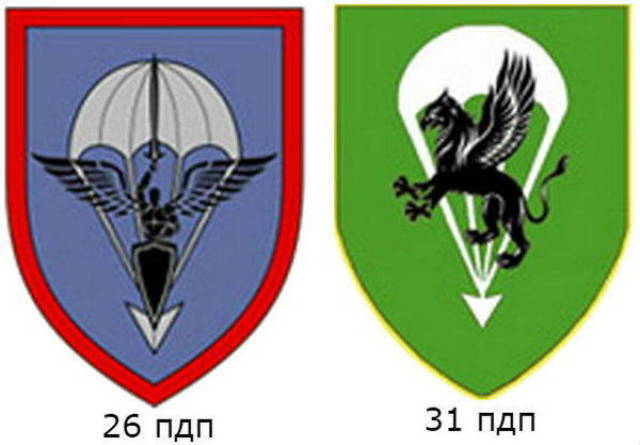
Emblems 26 and 31 of the pdpOrganizationally, the basis of each parachute regiment consists of five light parachute companies.
Of these, the personnel of the two PDR receive advanced basic qualifications and training for action as specialized forces. This allows you to perform special tasks and, above all, in special situations, effectively support the command of the SpN forces.
The main units In comparison with other infantry units, each pdr has three parachute platoons (pdv) and one heavy pdv. The PDV consists of a control department and three paratrooper departments.
The department is a closed system of 10 people with a variety of weapons and equipment. The armament, for example, includes 16 samples of personal and anti-tank weapons. The separation is formed by their two maneuverable elements (groups). Each group is headed by a sergeant major. Thus, the PDV is designed for independent performance of combat missions.
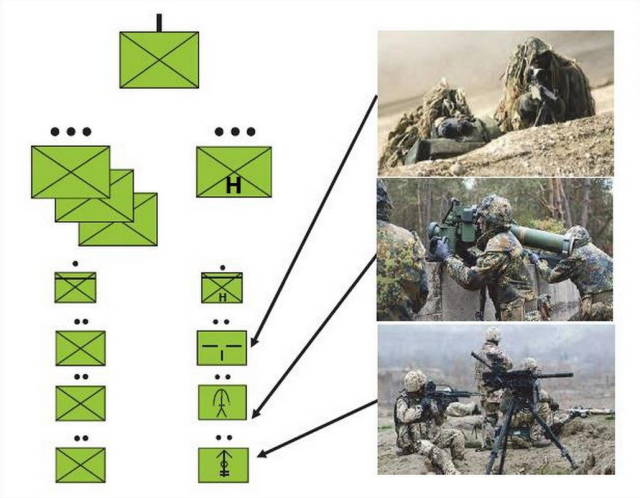
Organization of the parachute company of the BundeswehrThe heavy platoon includes sniper, anti-tank and automatic grenade launchers in three groups each.
The anti-tank department is armed with the ATGM "Milan". In the future, it is planned to replace the multi-purpose light guided missile system (Mehrrollenfähigen Leichten Lenkflugkörpersystem, MELLS) "Eurospike Elar" (Eurospike LR).
Fire and rear support forces Each parachute regiment includes one heavy PDR, designed to concentrate firepower on the main direction. Heavy pdr consists of six platoons:
- fire support platoon with four departments (groups) of joint tactical fire support (hereinafter referred to as OTP, Joint Fire Support Teams);
- three artillery platoons on the Vizel 1 APC with a 20 mm automatic cannon;
- anti-tank platoon on the Vizenl 1 APC with the Tou ATGM (in the future with the MELLS system);
- a mortar platoon equipped with eight 120 mm mortars.
In the headquarters and support company of the regiment, as another feature, there is a SpN platoon and a platoon of service dogs. In addition, the regiments have one parachute support company and a parachute medical and sanitary company each.
Equipment of the Bundeswehr Airborne Forces
Military equipment and means of landing
The main vehicle of the airborne troops of the Bundeswehr is an armored car "Mungo" (Mungo) from the company "Krauss-Maffei Wegmann" (Krauss-Maffei Wegmann). About 400 armored vehicles of this model serve primarily for the transportation of paratrooper squads, and are also used as command vehicles.
"Mungo" is suitable for airlift and has increased cross-country capability. The vehicle has a payload capacity of about two tons and provides protection against infantry weapons, hand grenades, shrapnel and anti-personnel mines.
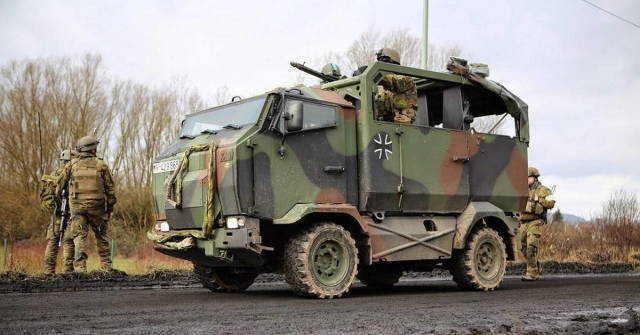 |
| BA Mungo. |
| Source: invoen.ru |
The airborne units are armed with about 100 airborne armored personnel carriers "Wiesel 1" (Wiesel 1) from the Rheinmetall company. The APC is used as a base for the Tow ATGM and the 20 mm automatic cannon. It is reported that the useful life of the armored personnel carrier will be extended until 2025.
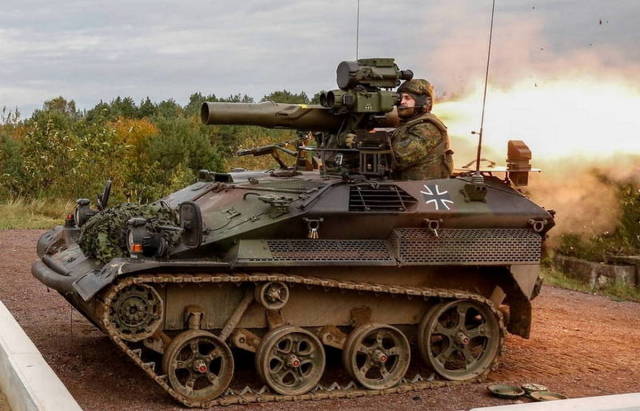
Wiesel 1 with TouCurrently, airmobile troops are awaiting completion of work on a major project to develop a transport airborne platform with extensive capabilities.
As the successor of the equipment in service, the platform should be delivered to the troops from 2025. It is planned to be used as a carrier for a variety of additional options: weapons, intelligence, OTP equipment, communications and management.
Part of this program is currently in service with the airmobile armored personnel carrier "Wiesel 2". The APC has a crew of seven people and is used as a commander and carrier transport with a variety of functions.

Airmobile armored personnel carrier "Wiesel 2"The service life of the T-10 and T-10R human amphibious parachutes has been extended.
The purchase of new controlled models of parachutes is scheduled for 2024. New models during descent will allow changing the direction of horizontal displacement of the parachutist, thanks to the opening or closing of valves on the dome.
Airmobile troops - the main types of weapons
According to the publications, 1 VDBR has at its disposal a large number of weapons, ammunition and optical devices used both by infantry forces and exclusively by airborne units. A significant part of the samples are scheduled to be replaced with more modern models.
In particular, the standard G36 rifle in service should be replaced by an improved assault rifle available on the market. The MG 5 machine gun from Heckler and Koch (Heckler und Koch) is being replaced by the MG 3 model.
Examples of sniper weapons in service are the G28 semi-automatic rifle and the 7.62 x 67 mm G22 rifle. The models have an effective firing range of up to 600 and 800 m, respectively. From the beginning of 2019, the G22 rifle will be upgraded and replaced with the G22 A2 version with a new sight, shoulder rest and hand protection (more details ).Calculation with a G22A2 sniper rifle
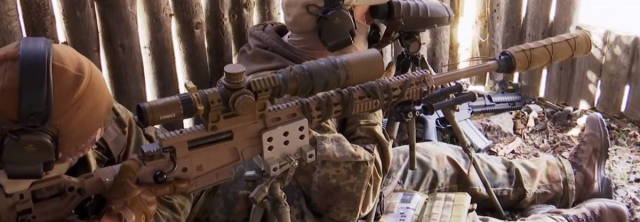
The G82 rifle with a caliber of 12.7 mm and a firing range of up to 1800 m in the future should be used in parachute platoons in a single copy, as well as in sniper and anti-tank detachments.
Weapons of a larger caliber are a 40 mm automatic grenade launcher and a 20 mm automatic cannon. They allow you to conduct supporting fire on areas at medium ranges.
Anti-tank weapons The hand-held anti-tank weapons of the airmobile troops of the Bundeswehr include the RPG "Panzerfaust 3" (Panzerfaust 3) and its modification "Bunkerfaust" (Bunkerfaust). Both models are developments of the company "Dynamit Nobel Defense" (Dynamit Nobel Defense). "Bunkerfaust" is designed to fight the enemy in fortified shelters. The RPG allows you to fire at a range of up to 400 m.
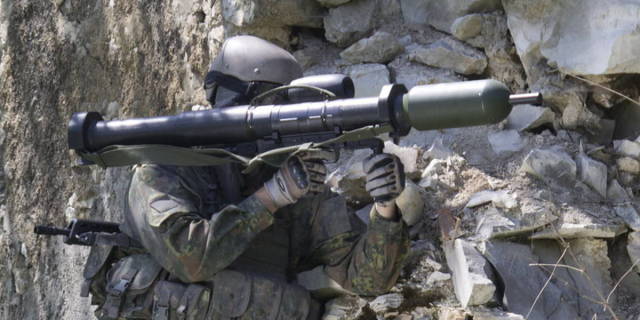
BunkerfaustThe German SV Command places considerable hopes on the MELLS "Eurospike LR" system.
It is reported about its deliveries in the coming years in a variant for use on foot. It is expected that the Eurospike LR will allow hitting armored vehicles, helicopters and stationary infrastructure elements with a horizontal hit or an attack from above at a range of up to 4000 m.
In the coming years, the German Airborne Forces will also receive a new means of destruction "Wirkmittel 90" (Wirkmittel 90) from Dynamit Nobel Defense. The new system allows firing at a range of up to 1200 m with shots with a fragmentation, lighting and anti-structural warhead.
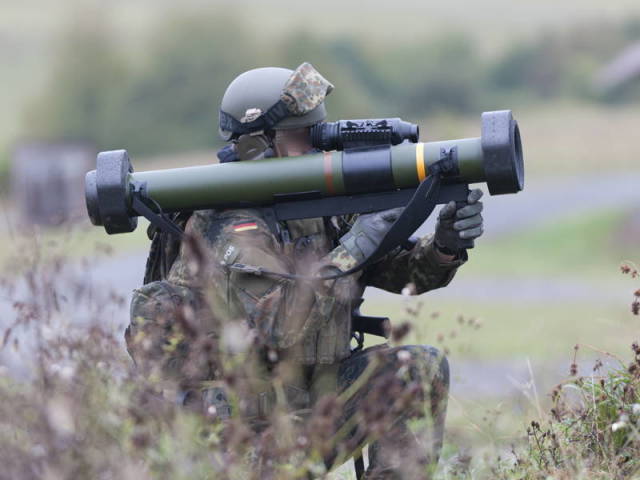
Wirkmittel 90 Grenade LauncherMortars The use of standard 120 mm mortars with an R-barrel manufactured by Rheinmetall has been extended until 2030. The mortar is capable of hitting the enemy at a range of more than 8000 m.
The remaining mortars were converted back in 2017 to an R-barrel with an O-ring in order to be able to fire new-generation ammunition with high-explosive, smoke action and infrared illumination. In addition, the Wolf vehicle is currently being tested, designed to become a new version of the transport mortar platform.
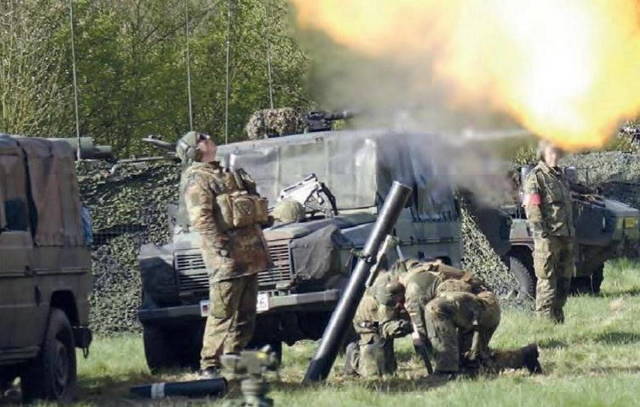 |
| Fire from a 120 mm mortar. |
| Source: invoen.ru |
A 60 mm mortar will be delivered to mortar platoons as secondary weapons and a "light means of mounted fire" from 2020. When assembled, with a barrel, plate, bipod and sight, it can be used at a range of up to 3500 m. Without additional equipment, the barrel is held by the hand, and the guidance is carried out by the shooter. Shooting from this position is possible at a range of 100 to 1500 m.
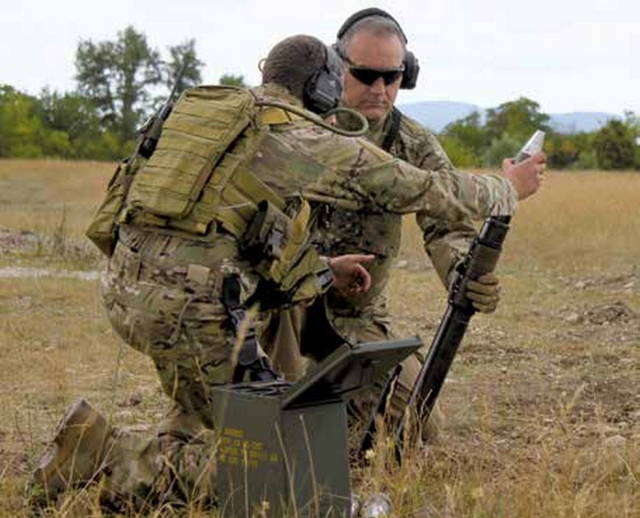
60 mm mortar systemBundeswehr Army Aviation - tasks and forces
Within the framework of ensuring air mobility in Germany, the leading task of army aviation units is the air transportation of personnel and cargo. Without the use of stationary ground infrastructure, army aviation transfers military units, material assets to short and medium distances, and evacuates the wounded and injured.
The main models of helicopters for performing transport and combat missions are the new NH90 helicopter (NATO-Helikopter 90) and the CH-53 medium transport helicopter currently transferred to the Air Force. The NH90 helicopter also allows you to perform communication, surveillance and reconnaissance tasks. These models can also be used during an airborne operation .
Medium transport helicopter CH-53Another option for the use of Bundeswehr army aviation is the close interaction of military transport helicopters with Tiger attack helicopters.
This type of tactical action received in the German Armed Forces the designation "aerial mechanization" (literally translated, or Luftmechanisierung). In fact, we are talking about the defeat of ground-based enemy attack helicopters and the suppression of their firepower. After that, landings of ground forces units are carried out and the main part of the airmobile operation is carried out with constant fire support from the air.
The Army aviation and the medium transport helicopter CH-53 also work closely with the command of the SpN and the forces supporting them.
Organization of the Bundeswehr Army Aviation
As mentioned above, the German Army aviation consists of three helicopter regiments: 36 Tiger attack helicopter regiment, as well as 10 and 30 transport helicopter regiments.
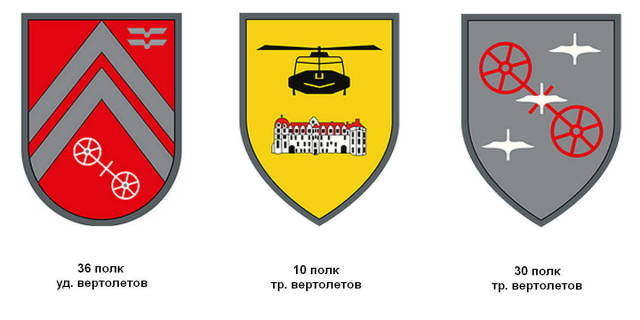
Emblems of Army aviation regiments of the BundeswehrThe 36th regiment of attack helicopters is armed with 32 Tiger helicopters.
The regiment performs the above-mentioned combat missions to support ground forces units from surface airspace independently or in cooperation with other forces.
The management of the regiment includes a headquarters with a headquarters and support squadron. The regiment is based on two strike squadrons of 16 Tiger helicopters each. The squadrons consist of four attack units of four helicopters each. The remaining three squadrons are assigned the tasks of technical support, maintenance and repair.
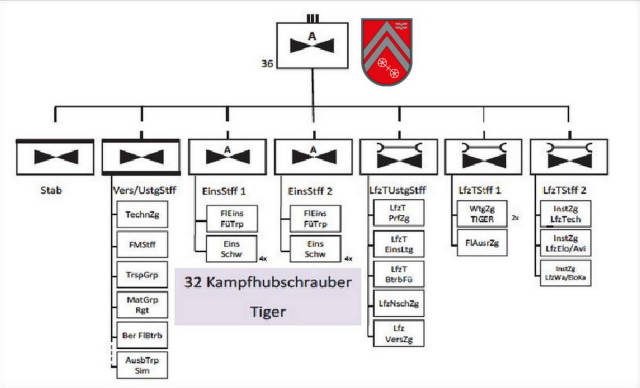
Organization of the 36th regiment of attack helicoptersThe transport helicopter regiments (10th and 30th) also have six squadrons with a similar structure.
Each regiment is armed with 36 NH90 helicopters. Two flight squadrons of each of the regiments can use up to 18 transport helicopters (four links of four NH90 helicopters). Additionally, two NH90 helicopters from each regiment are used in the interests of the Bundeswehr search and rescue service.
NH90 Transport helicopter The NH90 helicopter from the company "Energy Industries" (NH Industries) is designed to act as a tactical transport helicopter. The machine is capable of carrying a payload of up to 2.5 tons, and on an external suspension up to 4 tons. The flight range without additional fuel tanks is 800 km, with two additional tanks – 1260 km. At the same time, the duration of the flight will be up to 4.5 hours. At altitudes of about 6000 m, the NH90 reaches speeds of up to 305 km/h.
With various weapons options for control, reconnaissance or suppression of enemy air defense, the NH90 is suitable for use in an airmobile operation, often in conjunction with a Tiger attack helicopter. In addition to the crew of three people and depending on the presence of other personnel on board, the helicopter can transport up to 16 armed servicemen or 12 wounded lying down.
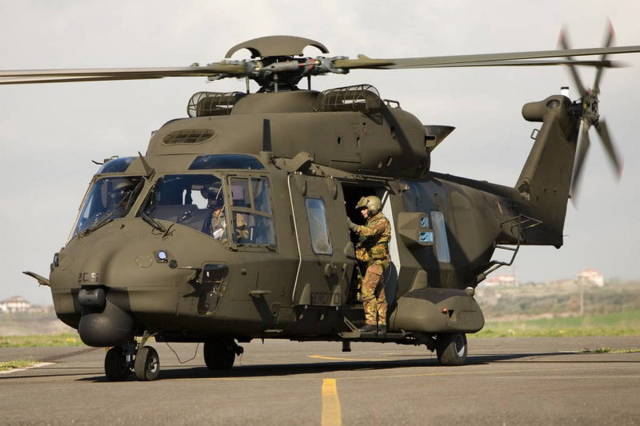
NH90 Transport HelicopterResume
According to military experts, today the airmobile troops of Germany are given extremely high importance. In this regard, their concentration in the special operations division is perceived as logical and justified. It ensures the rapid availability of airmobile units for combat use.
Experts believe that the timely completion of the purchase of modern Tiger and NH90 helicopters, bringing them to the planned configurations, as well as the implementation of these projects in the airborne troops guarantee further growth of their already high level of combat readiness.
At the same time, in a number of recent publications about Germany's long-term military planning for the period up to 2036, we are talking about three heavy divisions and the possibility of their reinforcement by the allies. In this regard, the question of the future role and place of airmobile troops and, in particular, airborne units, in relation to mechanized formations remains open. According to a number of military experts, this topic is of particular importance against the background of the newly increasing emphasis in the German Armed Forces on the defense of the country and the alliance.
Based on the materials of the magazines "Europäische Sicherheit & Technik" and "Hardthöehenkurier"
